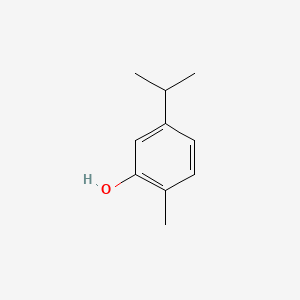| MeSH term | MeSH ID | Detail |
|---|---|---|
| Stomach Ulcer | D013276 | 75 associated lipids |
| Bacterial Infections | D001424 | 21 associated lipids |
| Pain | D010146 | 64 associated lipids |
| Pleurisy | D010998 | 20 associated lipids |
| Inflammation | D007249 | 119 associated lipids |
| Diabetes Mellitus, Type 2 | D003924 | 87 associated lipids |
| Diabetes Mellitus, Experimental | D003921 | 85 associated lipids |
| Body Weight | D001835 | 333 associated lipids |
| Edema | D004487 | 152 associated lipids |
| Arthritis, Experimental | D001169 | 24 associated lipids |
Carvacrol
Carvacrol is a lipid of Prenol Lipids (PR) class. Carvacrol is associated with abnormalities such as Consumption-archaic term for TB, Disintegration (morphologic abnormality), Infection, Corn of toe and Candidiasis of vagina. The involved functions are known as Stereochemistry, Anabolism, Oxidation, Process and Binding (Molecular Function). Carvacrol often locates in Skin, Nerve Tissue, Membrane, Endothelium and Plasma membrane. The associated genes with Carvacrol are P4HTM gene, TRPV3 gene, TRPV1 gene, TRPV2 gene and TRPV4 gene. The related lipids are Fatty Acids, Lipopolysaccharides, Octanols, Micelles and butyrate.
Cross Reference
Introduction
To understand associated biological information of Carvacrol, we collected biological information of abnormalities, associated pathways, cellular/molecular locations, biological functions, related genes/proteins, lipids and common seen animal/experimental models with organized paragraphs from literatures.
What diseases are associated with Carvacrol?
Carvacrol is suspected in Candidiasis of vagina, Infection, Infestation, Acquired partial lipodystrophy, Urticaria, Periodontitis and other diseases in descending order of the highest number of associated sentences.
Related references are mostly published in these journals:
| Disease | Cross reference | Weighted score | Related literature |
|---|
Possible diseases from mapped MeSH terms on references
We collected disease MeSH terms mapped to the references associated with Carvacrol
PubChem Associated disorders and diseases
What pathways are associated with Carvacrol
There are no associated biomedical information in the current reference collection.
PubChem Biomolecular Interactions and Pathways
Link to PubChem Biomolecular Interactions and PathwaysWhat cellular locations are associated with Carvacrol?
Visualization in cellular structure
Associated locations are in red color. Not associated locations are in black.
Related references are published most in these journals:
| Location | Cross reference | Weighted score | Related literatures |
|---|
What functions are associated with Carvacrol?
Related references are published most in these journals:
| Function | Cross reference | Weighted score | Related literatures |
|---|
What lipids are associated with Carvacrol?
Related references are published most in these journals:
| Lipid concept | Cross reference | Weighted score | Related literatures |
|---|
What genes are associated with Carvacrol?
Related references are published most in these journals:
| Gene | Cross reference | Weighted score | Related literatures |
|---|
What common seen animal models are associated with Carvacrol?
There are no associated biomedical information in the current reference collection.
NCBI Entrez Crosslinks
All references with Carvacrol
Download all related citations| Authors | Title | Published | Journal | PubMed Link |
|---|---|---|---|---|
| pmid: | ||||
| Cosentino S et al. | In-vitro antimicrobial activity and chemical composition of Sardinian Thymus essential oils. | 1999 | Lett. Appl. Microbiol. | pmid:10499301 |
| Stammati A et al. | Toxicity of selected plant volatiles in microbial and mammalian short-term assays. | 1999 | Food Chem. Toxicol. | pmid:10506004 |
| Ultee A et al. | Mechanisms of action of carvacrol on the food-borne pathogen Bacillus cereus. | 1999 | Appl. Environ. Microbiol. | pmid:10508096 |
| Pol IE and Smid EJ | Combined action of nisin and carvacrol on Bacillus cereus and Listeria monocytogenes. | 1999 | Lett. Appl. Microbiol. | pmid:10530038 |
| Mockute D and Bernotiene G | The main citral-geraniol and carvacrol chemotypes of the essential oil of thymus pulegioides L. growing wild in vilnius district (Lithuania). | 1999 | J. Agric. Food Chem. | pmid:10552723 |
| Zand RS et al. | Steroid hormone activity of flavonoids and related compounds. | 2000 | Breast Cancer Res. Treat. | pmid:10989984 |
| Ultee A et al. | Adaptation of the food-borne pathogen Bacillus cereus to carvacrol. | 2000 | Arch. Microbiol. | pmid:11081791 |
| pmid:11163945 | ||||
| Varel VH and Miller DN | Plant-derived oils reduce pathogens and gaseous emissions from stored cattle waste. | 2001 | Appl. Environ. Microbiol. | pmid:11229933 |
